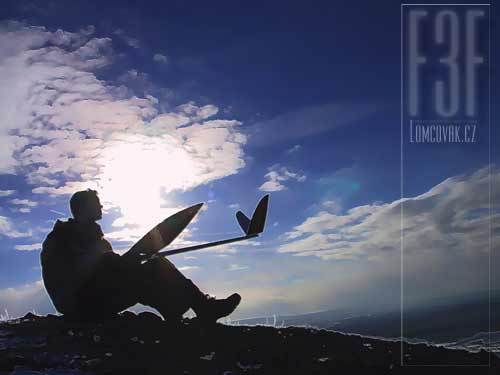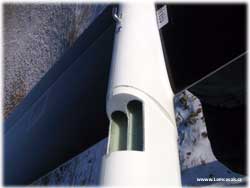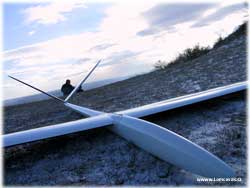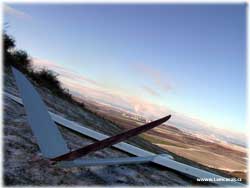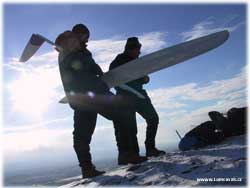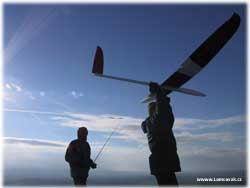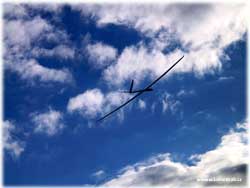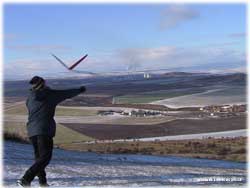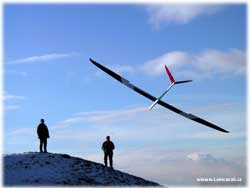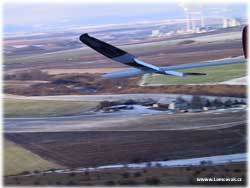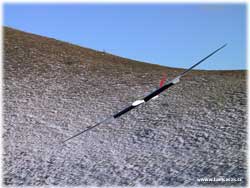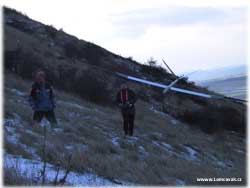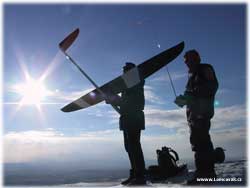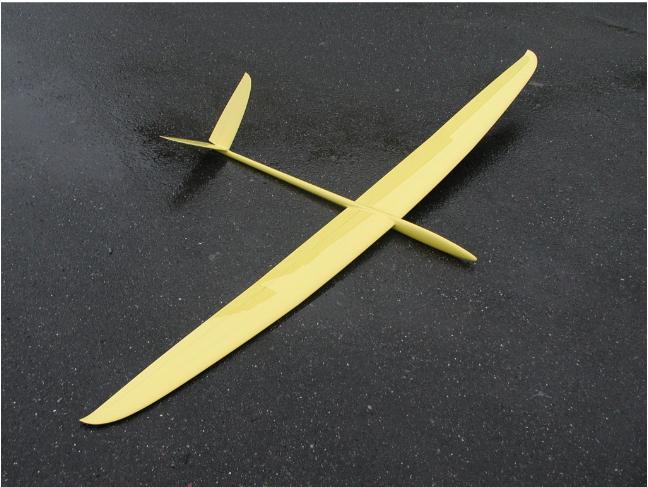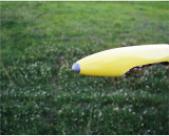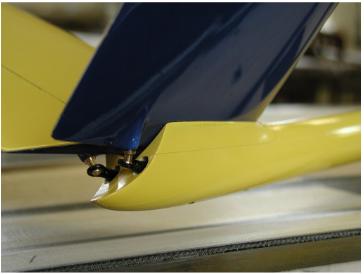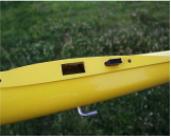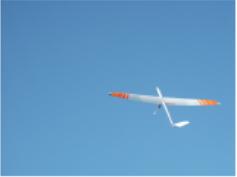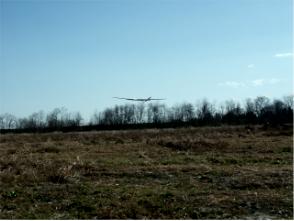| X21
/UMS Carbon |

Still today I feel
sun, fresh air and spirit of this famous F3F side in Bohemia, Ranapan. Crazy
weather here. If two weeks ago there was -10C (14F) now on sun is temperature
raising to +20C (68F). Not so good for skiing, but for flying F3B, excellent.
(By Endlich 23, December, 2001) A F3B glider arrived before Christmas from
Mr. Jiri Tuma. |
|
Air
foil
|
Wing
Length |
3,200mm
|
| Cord
Length |
240mm
|
| Wing
type |
MH32
|
| Wing
Area |
dm2
|
| Wing
Load |
g/dm2
|
| Structure |
See
the comments
|
| Portability |
2 pieces
|
|
|
|
Tail
plane
|
Tail
type |
V-Tail,2
point screw |
| Section |
|
|
|
|
etc.
|
Total
Weight |
2,180g(Ballast:800g) |
| Radio
gear |
6
Servos, 7 Channels
|
Fuselage
Length
|
1,430mm |
|
X21,
a F3B model development has been just finalized by Mr. Jiri Tuma who is
famous as the designer and manufacturer of Xantipa one of F3J models. It
took more than three years since he started to hatch up his new model. We
may have finally new X21 model. . A prototype model of X21 was unfortunately
jackknifed while launching in Japan. The reason of this accident did not
come from its design, but entry level mistake during manufacturing process
(Spar did not fully contact with the inside of skin.) Through lots of test
flight of X-21 in Japan, many comments
(see below) have been issued by Japanese fliers the X-21 and
many improvements have been added into X-21. Here we may have an exquisite
new F3B model, X-21 using UMS carbon (light
and stiff) at last. We must thank for the contribution by the Japanese fliers
in Kamisato flying club, Mr. Iwata, Mr. Hamada and Mr. Hashimoto.
In Japan, Mr. Hamada recorded 18 seconds constantly in the all Japan F3B
Championship, March 2002. Mr. Iwata and Hashimoto have sometimes recorded
15 seconds, informal flight. Those records as well as the record by Mr.
Tuma himself, proves that X-21 is one of F3B competition model and that
X-21 is an ultimate F3B fighter so far. New X-21 is available since August,
2002 in Japan.
In European countries(Norway,
etc.), X-21 is famous as a slope fighter, too. The beautiful picture on
the top was taken at Ranapan in Bohemia and uploaded in the site of Roman
Vojteck. Most of F3B models made in Czech Republic are designed
as F3J model originally, and are reinforced such as Pike/F3B and Eraser2000/F3B.
And there are few F3B models that was designed as F3B model originally in
Czech Republic. It is X21 that is designed as a F3B model originally in
Czech. Mr. Tuma himself is a excellent pilot as well as a manufacturer who
is a flier who flies his prototype model until he understand it comfortable
enough. This has been already proved by Xantipa, a excellent F3J model.
Since I heard his plan to develop new model at the end of 20th century,
the name of new model was presumed as "21st model type X" tentatively.
However a name, X21 became its formal name. X21 was stared to be rolled
out since August 2001. X21 looks like Estrella, because of its skinny fuselage
and its narrow airfoil. The airfoil is divided into two wing pieces. Though
its flying performance is unknown, it seems to be valuable for us to expect
his bigotry. Flight performance is available in the comments bellow. |
 |
|
Designer
/Manufacturer
|
| Jiri
Tuma/JITOM (Czech Republic) |
 |
|
 |
|
Price/Shop
|
| Dealer |
RC-Sailplane.com
(Please contact with RC-Sailplane.com) |
 |
| Price
|
Full
Carbon airfoil (excluding tax and shipment cost) |
TBD |
| D-Carbon
airfoil (excluding tax and shipment cost) |
TBD |
| Glass
airfoil (excluding tax and shipment cost) |
TBD |
|
|

|
|
|
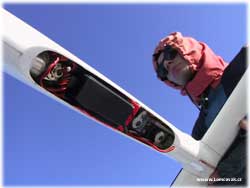 |
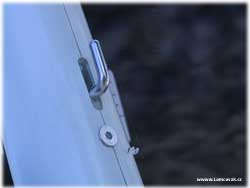 |
|
|
Ranapan
in Bohemia, famous slope side.
On Dec. 23, 2001. We got F3B glider from Jiri Tuma before Christmas.
|
Radio
Gear. Slim body seems to refuse to install some electronic stuff... ,An
cantina line can be seen out of fuselage.
|
..
Hook ...
|
ballast
inlet. (Original brass ballast's are available.. )
|
|
|
|
|
|
|
..for
tuning flying phases
|
Waiting
for wind..
|
...but
in the air its the best ...
|
Yes,
I 'm ready...
|
|
|
|
|
|
|
.Go
Go!!
|
..
In the high place,...
|
.Through
into airborne
|
...always
under control..
|
|
|
|
|
|
|
.
... .crowing quite well...
|
will
you hit me or not ?...
|
Final
approach..
|
.
.. last flight and lets go to the pub.
|
|
|
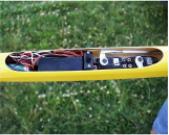 |
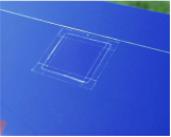 |
|
|
X-21
with beautiful aspect
|
Radio Gear |
Flat Servo
Cover |
Nose
cone with
|
|
|
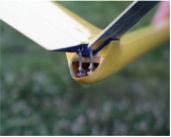 |
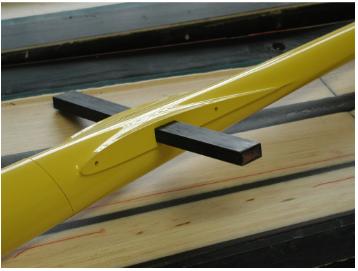 |
|
|
V-tail
(original)
|
V-tail
(Current model) |
Fat
carbon joiner with Kevler core |
Hook
and electric cable connector.
(There is water proof type)
|
|
|
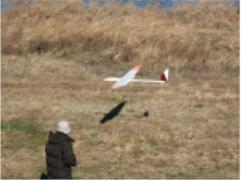 |
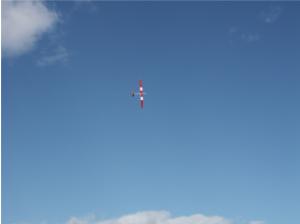 |
|
|
F3B
Flight of X21 in Japan of Mr. Hamada. Trial of X-21 experiments.
|
Mr.
Hamada and X-21 in landing approach
|
X-21
turn with background of Mt. Akagi, Japan
|
...Good
flight today, too.
|
 |
| Fuselage.. |
There
were many issues in the prototype of X-21. The first one is that there was
not any clear pass for the Aluminum control rods for V-tail in the fuselage
if Futaba servos were used, because servo horn height was too short. Therefore
the rods must be bent like S-shaped.
When servo height is too short, because the control rod contacts with ballast
tube end, the control rod must be bent. So Mr. Hamada recommended to use
long carbon rods and vinyl pipe with 2mm diameter, which fixed this issue.
Improved X-21 can equip either vinyl tube or aluminum rods as an option.
As the priority was put on the light weight in the stage of prototype, the
strength of the fuselage was very light but, not strong enough. The inner
surface of fuselage was tried to be reinforced by such various type as carbon
roving, or spiral carbon cross tape or carbon cross, because of experiments.
But Kevler and Carbon cross was adopted finally for the inner surface reinforcement
of fuselage.
The servo mount in the fuselage of X-21 is a very conventional veneer plate.
As those who know legacy sailplane must know, the plate adhered by normal
Epoxy can be unstick by small force or shock. Mr. Hamada recommends to use
silicone adhesive or bath cork adhesive.
There is a hole of head of fuselage where nose ballast is equipped. This
hole help you to place ballast at very end of fuselage and therefore reduce
the total amount of ballast in the fuselage for catching balance. |
 |
| Wing... |
Flat
geometry: The airfoil of X-21 strongly tapers at the end of the
wing tip, This flat geometry for the airfoil tends theoretically to cause
stalling at wing tips within the low speed range such as a final stage of
Task B. This argument does not only to the case of X-21. However X-21 has
an excellent performance in cycling of Task A (thermal duration) as carrying
our mind back to Xantipa.
Though COBRA or ERASER has MH32 profile which is the same of that of X-21,
this tapering airfoil of X-21 shows completely different flying performance
from them because of the high aspect ratio of airfoil In Task C, this airfoil
with high aspect ratio also achieves remarkable speed up to 15 sec (informal
record). Some X-21 prototypes load ballast at both before and after spar
in the airfoil to reinforce airfoil stiffness. However it resulted in a
heavy airfoil In addition, the stiffness can be achieved by contacting spar
and wing skin properly without reinforcement by ballast tube before an after
spar. So we recommended that the ballast tube in the airfoil should be optional.
Since there were partially unstiff
portion at the end of wing, it was reinforced. (This portion need not
be reinforced, but there are someone who lands at the end of wing and another
checks stiffness of the airfoil with holding one side of the wing tip end
and shaking it!!.)
Stiffness of the airfoil: We asked to make such airfoil as carbon-balsa-carbon
sandwich to reinforce airfoil But total weight became 60g heavier. Mr. Tuma
decided to use UMS carbon to reinforce airfoil and reduce its weight. UMS
carbon is well known as the stiffer and lighter material than normal material.
| V-tail
mount:
V-tail is mounted
by two screw bolts such as following figure. Screws are made tight
from under V-tail. In the prototype, flat veneer was used as mount.
But we had accident three times that this flat veneer plate pushed
the V-shaped mount in the hard landing and broke both V-shaped mount
and V-tail itself. So Mr. Hashimoto and Mr. Hamada recommended that
V-shaped carbon plate should be used instead of flat veneer which
is able to reinforce V-tail mount and reduce weight. |
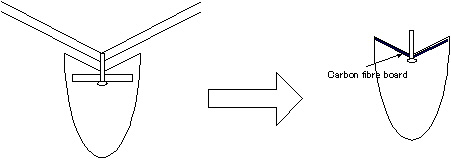 |
|
The
spar in the V-tail of prototype scanned up to the middle of V-tail. There
remained some un-sharpness of elevator control in the steep turn of Task
C because of small deflection of V-tail. There is another reason for this
un-sharpness as a matter of course, such as control rod, pilot skill and
so on. Therefore this factor is minor one.
The levers for moving wing of V-tail positioned at blue line originally.
This position tends to loose control. Mr. Hamada recommended to change location
of lever to fat solid line in the right figure. It will improve the strength
of adhesion between lever and moving wing. This idea is adopted by Ellipse,
Tragi and so on. |
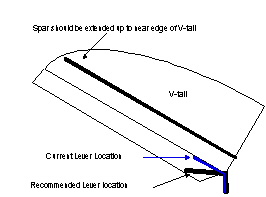 |
 |
| Flying... |
It
was September, 2001 that the maiden flight of the prototype of X-21 in Japan
was executed. Mr.
Hamada belong to Kamisato
Sailplane club flew X-21 in Japan. Mr. Hamada is a
man of power who always challenge anything. He is the best flier of
X-21 which attempts to the limit of speed. Mr.
Iwata, leader of this club and Mr. Hashimoto,
a member of this club also flew X-21 during the same time frame. After only
two weeks, Mr. Iwata met such an accident that his X-21 jackknifed while
launching. The reason was the spar in the airfoil did not contact with inner
skin. This is an error during assembling models. The above improvements
relates to only design not assembling. There was no need to change any fluid-dynamics
design of X-21. The flight impression of X-21 with original design are as
follows;
Launching: angle just after releasing X-21 is very steep and
good tension can be obtained. However enough tension of launching string
is needed, otherwise X-21 can not have enough buoyancy just after release.
The response of elevator is sharp enough when carbon rod is used. After
launching, X-21 did not lose speed and obtained enough height which is the
same as Estrella. The airfoil did not deflect while launching. Therefore
the stiffness of airfoil seems to be enough.
Thermal duration task: Since the wing
area of X-21 is smaller than F3B fighter with
normal aspect ratio, it was thought that X-21 was not good at thermal duration.
Contrary to expectations, the flight performance is very good in Task A.
The response seems to be excellent. In case of the profile MH32, sailplane
tends to have its head down in the high speed range. As for X-21, such tendency
is very mild.
It may be because of washout of airfoil of X-21.
Task B by X-21 can be expected. Gliding ratio seems to be very high, that
is, long foot.
Speed task: A remarkable
characteristics of X-21 is that its attained height is very
high even without ballast. When X-21 dives from high altitude, acceleration
is very comfortable, the speed decrease very little even at final lap of
Task C. X-21 is algate, very rapid. Though the elevator response was a little
mild, when aluminum rods are used. In other words, flight curve at turn
of Task C might become bigger circle. But after replacing rods by carbon
rods, its response was extremely improved. Negative displacement at Task
C maybe 1-2mm enough from neutral.
Anyway, X-21 is cheap but excellent F3B fighter.
|
|

|
Standard
trim and How
to Make X21
Basic trim are shown here.
Detail infromation for assembling X-21 is available in the homepage of Mr.
Kanoh. (Sorry. It is writen only in Japanese. But beautiful pictures
will give you some idea for you.) |
 |
|
Fliers
Since X21 was veiled
out and its production began August 2001, there are very new number of X21
in the world. The pictures of the first X21 in Japan is available, if you
click here. |
 |

